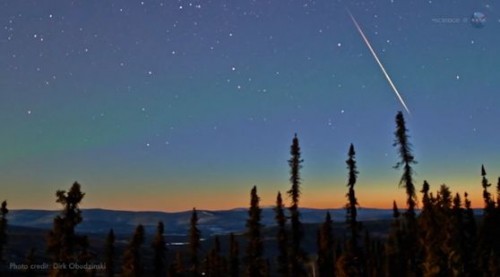The shower, which should be called the giraffe shower (Camelopardalids) was created as a result of the Earth passing through dust grains left by the periodic comet 209P/LINEAR in the 19th century

Yesterday, Independence Day, the sky was filled not only with fireworks, but also meteors from a shower Hata Aquarids, However, this month meteor fans are in for another surprise, as reported by the NASA website.
The director of the meteorite division at NASA, Dr. Bill Cook leaves his cameras to do the sky observations for him. Cook and his colleagues operate an automated network of cameras looking for fireballs spread across the entire US territory and which capture anything that falls and burns in the atmosphere.
Early in the morning of May 24th he intends to go out in person. "There is a reasonable chance of a new meteor shower and I want to see it with my own eyes," Cook said.
The shower, which should be called the giraffe shower (Camelopardalids) was created as a result of the penetration of dust grains from the periodic comet 209P/LINEAR. No one has seen the shower yet, but this year, the giraffe shower may rival August's famous Perseid shower. "There are astronomers who expect a rate of 200 meteors per hour," Cook said.
Comet 209P/LINEAR was discovered in February 2004 by the Linar (Near-Earth Asteroid Research project) joint project of NASA, MIT's Lincoln Laboratory and the US Air Force. It's a pretty dim comet, dipping into Earth's orbit once every five years as it makes a loop around the Sun.
Two years ago, meteor experts Eko Littinen from Finland and Peter Jennikens at NASA's Ames Research Center announced that the Earth was about to cross the remnants left behind by comet 209P/LINEAR. Streams of dust ejected by the comet in the 19th century may cross Earth's orbit on May 24, 2014. The result, they say, may be an impressive eruption of meteors.
Other experts agree with them but only partially. There is a wide consensus among observers that the Earth will indeed cross the stream of fragments on May 24th, however no one is sure how many fragments await there, it all depends on the question of how active the comet was over a century ago when the stream of these fragments was left there in the first place.
"We have no idea what this comet was doing in the 19th century," Cook said. As a result of uncertainty, all options are open, either there will be an impressive meteor shower, or total disappointment."
The best time is to watch the sky between six and eight in the morning (who is of course in a dark area at those hours, in Israel it is 0900-1100 in the morning). Therefore, viewers in North America will have a preferred location because for them the peak hours will be between 2-4 am (East Coast Time) and the radiant of the meter will be high in the sky.
"We expect the meteors to have exited from a point in the Giraffe cluster, a rather pale cluster next to the North Star," Cook said. "She will shine all night and direct the way for those who watch that night." However, since this is a new meter, there may be eruptions many hours before or after the predicted peak.
In case of disappointment, viewers are still in for a consolation prize, on May 24, as the Mount of the Moon and Venus come very close for a transit that will occur one day later. They will rise together just before the sun in the eastern sky at dawn. "It's always a beautiful way to start the day, with or without meteors," Cook said.
A new NASA video describes the expectations for the new meter
